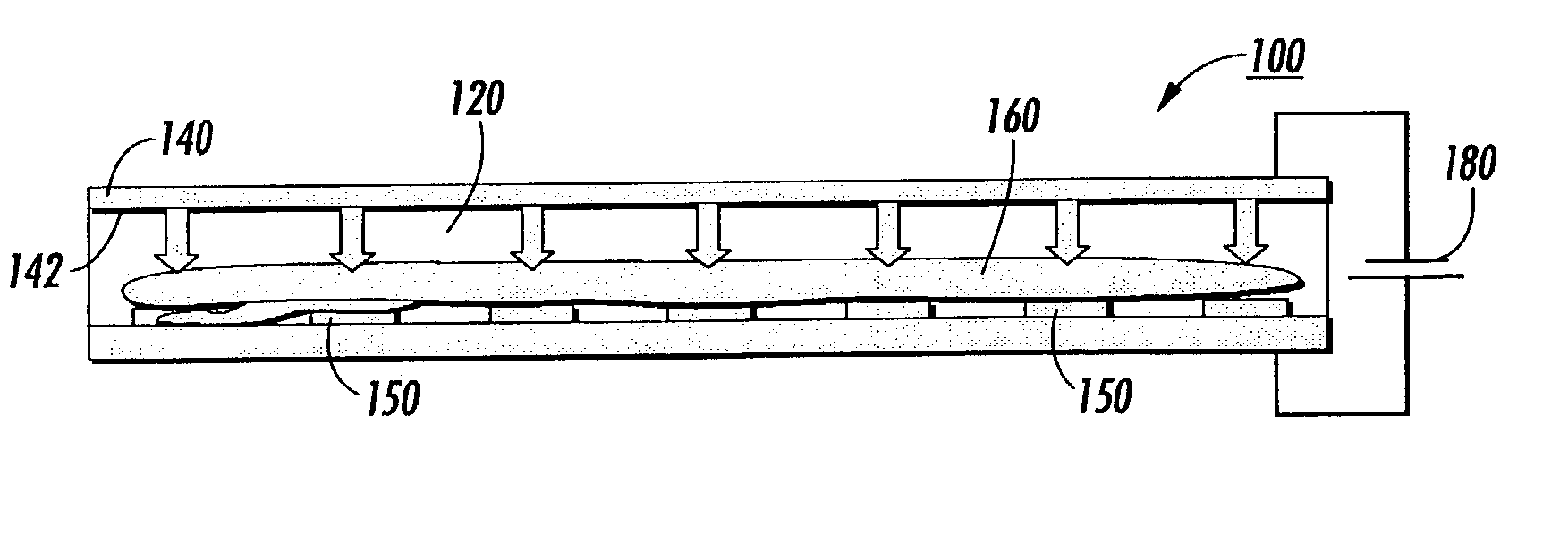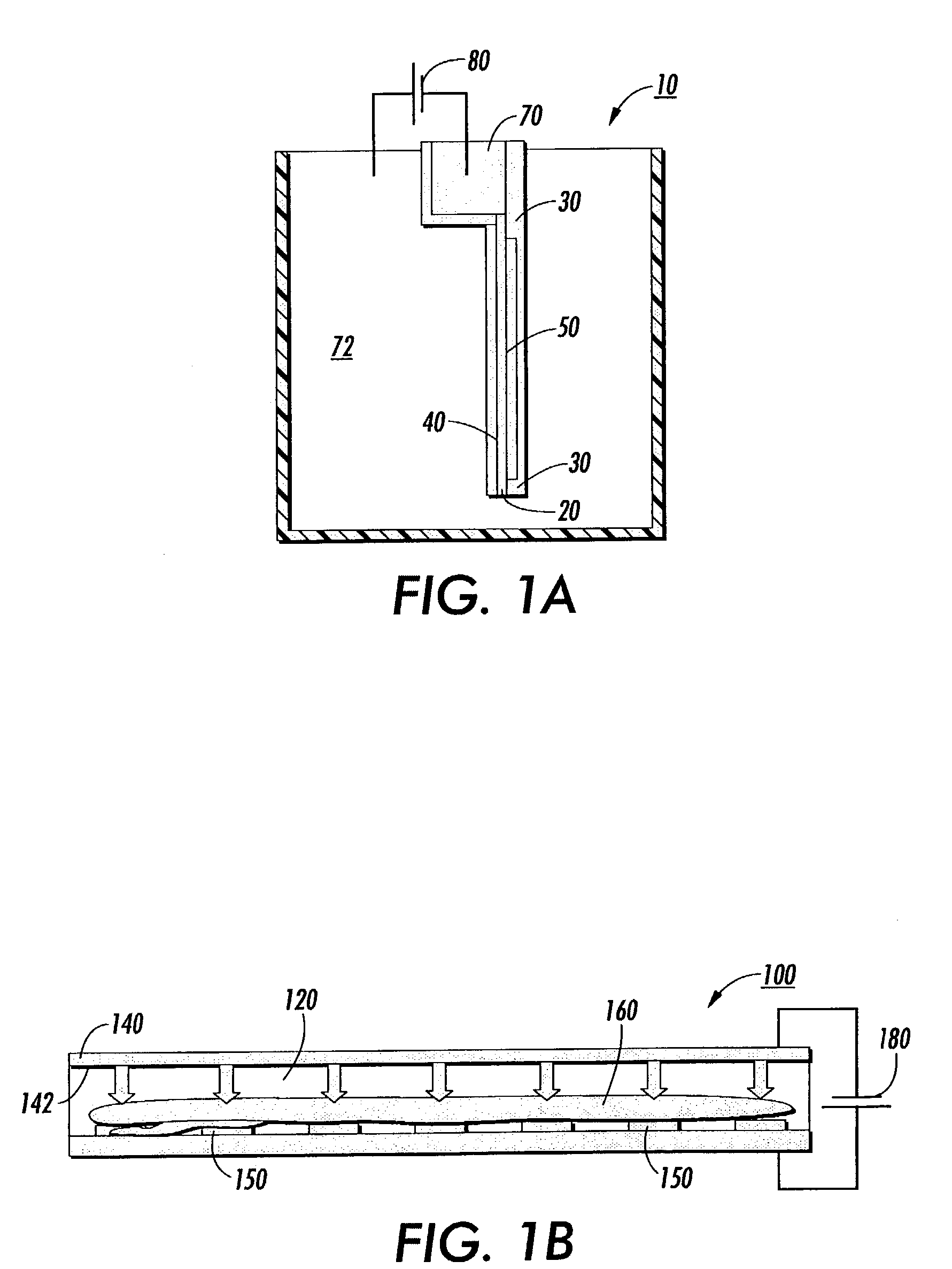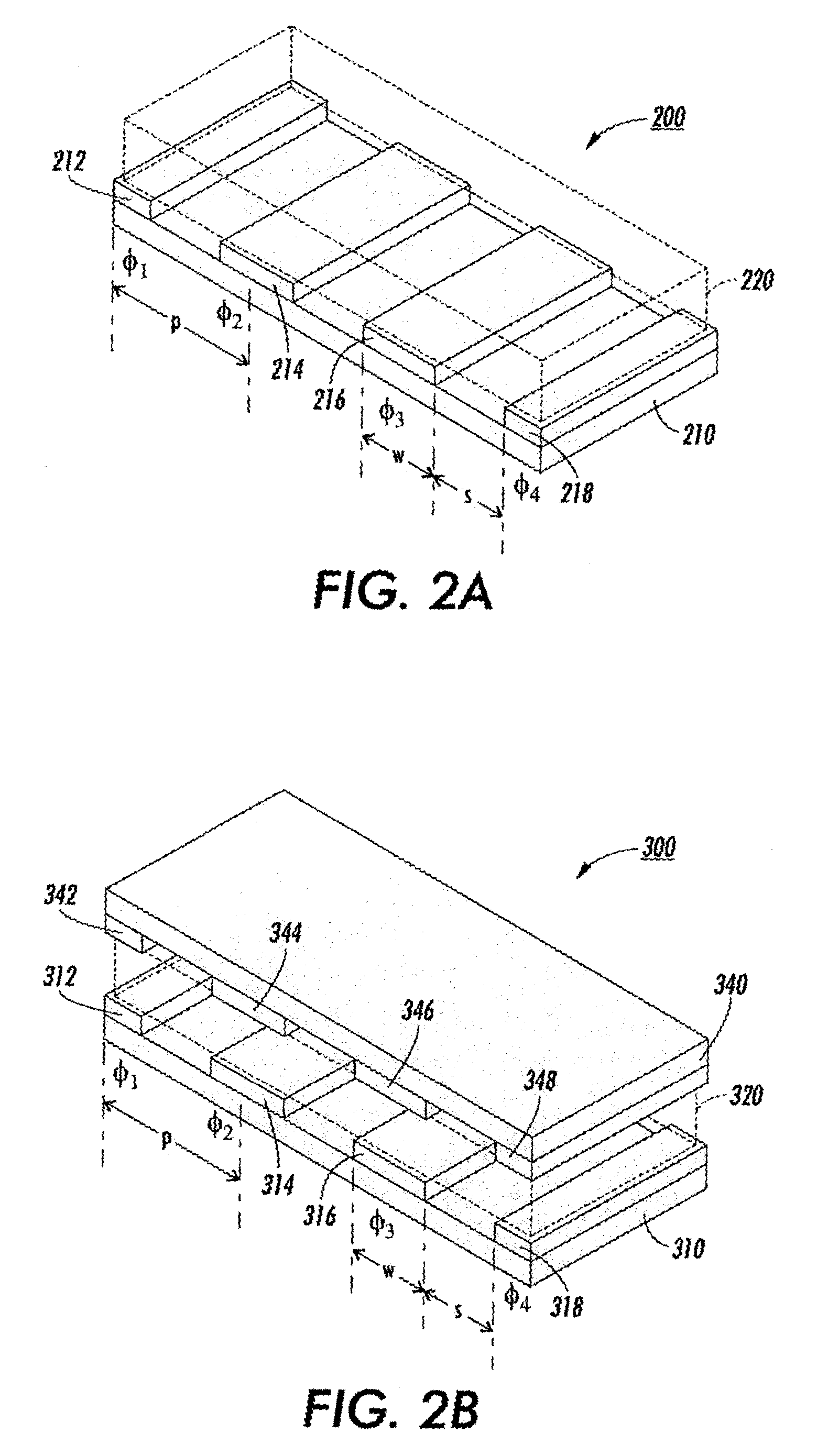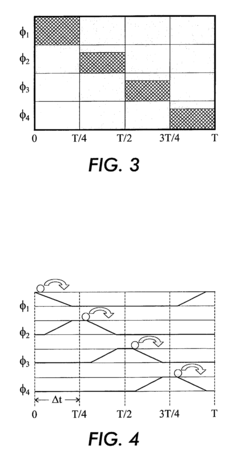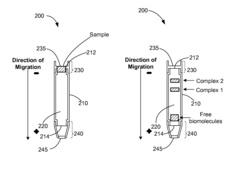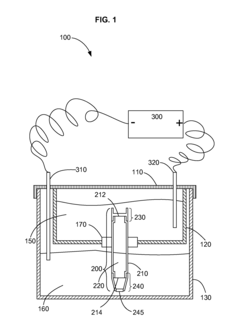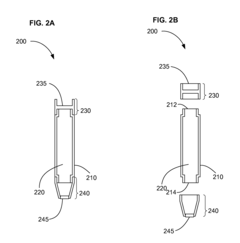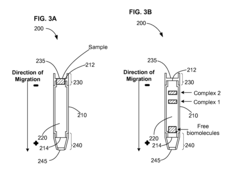Gel Electrophoresis in Cellular Biology: Next Steps
JUN 30, 202511 MIN READ
Generate Your Research Report Instantly with AI Agent
Patsnap Eureka helps you evaluate technical feasibility & market potential.
Gel Electrophoresis Evolution and Objectives
Gel electrophoresis has been a cornerstone technique in cellular biology for decades, evolving from its inception in the 1930s to become an indispensable tool for separating and analyzing macromolecules. The technique's journey began with Arne Tiselius's pioneering work on protein separation, which laid the foundation for modern electrophoretic methods. Over time, gel electrophoresis has undergone significant refinements, adapting to the changing needs of biological research.
The evolution of gel electrophoresis has been marked by several key milestones. The introduction of polyacrylamide gels in the 1950s greatly improved resolution and versatility. The development of sodium dodecyl sulfate-polyacrylamide gel electrophoresis (SDS-PAGE) in the 1960s revolutionized protein analysis by allowing separation based on molecular weight. The 1970s saw the advent of agarose gel electrophoresis for nucleic acid separation, which became crucial in the era of molecular biology and genomics.
Recent advancements have focused on enhancing sensitivity, speed, and automation. The introduction of capillary electrophoresis and pulsed-field gel electrophoresis has expanded the technique's capabilities, allowing for the separation of larger DNA molecules and improving resolution. Additionally, the integration of fluorescence-based detection methods has significantly increased sensitivity and enabled real-time monitoring of separations.
The primary objectives of current research in gel electrophoresis within cellular biology are multifaceted. One key goal is to further improve resolution and sensitivity, particularly for the analysis of complex biological samples containing a wide range of molecular sizes and charges. Researchers are also striving to develop more environmentally friendly and biocompatible gel materials to reduce the use of toxic compounds in the electrophoresis process.
Another important objective is to enhance the technique's applicability to emerging areas of cellular biology, such as single-cell analysis and proteomics. This involves developing methods for handling extremely small sample volumes and improving the detection of low-abundance molecules. Additionally, there is a push towards miniaturization and integration with other analytical techniques, aiming to create comprehensive "lab-on-a-chip" systems for rapid and efficient cellular analysis.
The future of gel electrophoresis in cellular biology is likely to see a convergence with advanced imaging and data analysis technologies. Machine learning algorithms are being developed to automate gel image analysis and interpretation, potentially leading to more accurate and standardized results. Furthermore, researchers are exploring the integration of gel electrophoresis with mass spectrometry and next-generation sequencing platforms to provide more comprehensive molecular profiling of cellular components.
The evolution of gel electrophoresis has been marked by several key milestones. The introduction of polyacrylamide gels in the 1950s greatly improved resolution and versatility. The development of sodium dodecyl sulfate-polyacrylamide gel electrophoresis (SDS-PAGE) in the 1960s revolutionized protein analysis by allowing separation based on molecular weight. The 1970s saw the advent of agarose gel electrophoresis for nucleic acid separation, which became crucial in the era of molecular biology and genomics.
Recent advancements have focused on enhancing sensitivity, speed, and automation. The introduction of capillary electrophoresis and pulsed-field gel electrophoresis has expanded the technique's capabilities, allowing for the separation of larger DNA molecules and improving resolution. Additionally, the integration of fluorescence-based detection methods has significantly increased sensitivity and enabled real-time monitoring of separations.
The primary objectives of current research in gel electrophoresis within cellular biology are multifaceted. One key goal is to further improve resolution and sensitivity, particularly for the analysis of complex biological samples containing a wide range of molecular sizes and charges. Researchers are also striving to develop more environmentally friendly and biocompatible gel materials to reduce the use of toxic compounds in the electrophoresis process.
Another important objective is to enhance the technique's applicability to emerging areas of cellular biology, such as single-cell analysis and proteomics. This involves developing methods for handling extremely small sample volumes and improving the detection of low-abundance molecules. Additionally, there is a push towards miniaturization and integration with other analytical techniques, aiming to create comprehensive "lab-on-a-chip" systems for rapid and efficient cellular analysis.
The future of gel electrophoresis in cellular biology is likely to see a convergence with advanced imaging and data analysis technologies. Machine learning algorithms are being developed to automate gel image analysis and interpretation, potentially leading to more accurate and standardized results. Furthermore, researchers are exploring the integration of gel electrophoresis with mass spectrometry and next-generation sequencing platforms to provide more comprehensive molecular profiling of cellular components.
Market Demand Analysis for Advanced Gel Electrophoresis
The market demand for advanced gel electrophoresis in cellular biology is experiencing significant growth, driven by the increasing complexity of research in genomics, proteomics, and molecular biology. As researchers delve deeper into understanding cellular processes and genetic variations, there is a growing need for more sophisticated and efficient separation techniques.
One of the primary factors fueling this demand is the expanding field of personalized medicine. The ability to analyze individual genetic profiles requires high-resolution separation of DNA and RNA fragments, which advanced gel electrophoresis systems can provide. This trend is particularly evident in cancer research, where identifying specific genetic markers can lead to more targeted therapies.
The biopharmaceutical industry is another major driver of market demand. As the development of biologics and biosimilars continues to accelerate, there is an increased need for precise protein characterization and quality control. Advanced gel electrophoresis techniques, such as 2D gel electrophoresis and capillary electrophoresis, offer the resolution and reproducibility required for these applications.
In the academic research sector, the push for more comprehensive studies of cellular proteomes is creating a demand for high-throughput gel electrophoresis systems. These systems allow for the simultaneous analysis of multiple samples, significantly reducing research time and increasing productivity.
The emergence of new applications in fields such as epigenetics and metabolomics is also contributing to market growth. These areas require the separation and analysis of complex mixtures of biomolecules, driving the need for more advanced gel electrophoresis technologies that can handle diverse sample types and provide higher sensitivity.
Environmental and food safety sectors are showing increased interest in gel electrophoresis for detecting contaminants and genetically modified organisms. This expansion into new markets is expected to further boost demand for advanced systems and consumables.
Geographically, North America and Europe continue to dominate the market due to their well-established research infrastructure and high R&D spending. However, the Asia-Pacific region is experiencing the fastest growth, driven by increasing investment in life sciences research and the expansion of biotechnology industries in countries like China and India.
The COVID-19 pandemic has also highlighted the importance of rapid and accurate molecular diagnostic tools, potentially accelerating the adoption of advanced gel electrophoresis techniques in clinical settings. This could open up new market opportunities in the healthcare sector, particularly for point-of-care applications.
As the demand for more precise and efficient separation techniques grows, manufacturers are focusing on developing automated systems with improved resolution, faster run times, and enhanced data analysis capabilities. This trend towards automation and integration with other analytical techniques is expected to shape the future of the gel electrophoresis market.
One of the primary factors fueling this demand is the expanding field of personalized medicine. The ability to analyze individual genetic profiles requires high-resolution separation of DNA and RNA fragments, which advanced gel electrophoresis systems can provide. This trend is particularly evident in cancer research, where identifying specific genetic markers can lead to more targeted therapies.
The biopharmaceutical industry is another major driver of market demand. As the development of biologics and biosimilars continues to accelerate, there is an increased need for precise protein characterization and quality control. Advanced gel electrophoresis techniques, such as 2D gel electrophoresis and capillary electrophoresis, offer the resolution and reproducibility required for these applications.
In the academic research sector, the push for more comprehensive studies of cellular proteomes is creating a demand for high-throughput gel electrophoresis systems. These systems allow for the simultaneous analysis of multiple samples, significantly reducing research time and increasing productivity.
The emergence of new applications in fields such as epigenetics and metabolomics is also contributing to market growth. These areas require the separation and analysis of complex mixtures of biomolecules, driving the need for more advanced gel electrophoresis technologies that can handle diverse sample types and provide higher sensitivity.
Environmental and food safety sectors are showing increased interest in gel electrophoresis for detecting contaminants and genetically modified organisms. This expansion into new markets is expected to further boost demand for advanced systems and consumables.
Geographically, North America and Europe continue to dominate the market due to their well-established research infrastructure and high R&D spending. However, the Asia-Pacific region is experiencing the fastest growth, driven by increasing investment in life sciences research and the expansion of biotechnology industries in countries like China and India.
The COVID-19 pandemic has also highlighted the importance of rapid and accurate molecular diagnostic tools, potentially accelerating the adoption of advanced gel electrophoresis techniques in clinical settings. This could open up new market opportunities in the healthcare sector, particularly for point-of-care applications.
As the demand for more precise and efficient separation techniques grows, manufacturers are focusing on developing automated systems with improved resolution, faster run times, and enhanced data analysis capabilities. This trend towards automation and integration with other analytical techniques is expected to shape the future of the gel electrophoresis market.
Current Challenges in Gel Electrophoresis for Cellular Biology
Gel electrophoresis remains a cornerstone technique in cellular biology, yet it faces several significant challenges that hinder its advancement and application in modern research settings. One of the primary issues is the limited resolution for separating complex mixtures of biomolecules, particularly when dealing with proteins or nucleic acids of similar sizes. This limitation becomes increasingly problematic as researchers delve into more intricate cellular processes and require finer discrimination between molecular species.
Another pressing challenge is the time-consuming nature of traditional gel electrophoresis protocols. The lengthy preparation and running times can be a bottleneck in high-throughput studies, impeding the pace of research in fast-moving fields such as genomics and proteomics. This inefficiency is particularly pronounced when dealing with large numbers of samples or when rapid results are crucial for time-sensitive experiments.
The reproducibility of gel electrophoresis results also presents a significant hurdle. Variations in gel composition, running conditions, and sample preparation can lead to inconsistencies between experiments, making it difficult to compare results across different laboratories or even within the same research group. This lack of standardization can undermine the reliability of findings and complicate the validation of experimental outcomes.
Environmental concerns and safety issues associated with the use of certain reagents in gel electrophoresis pose additional challenges. For instance, the reliance on toxic compounds like ethidium bromide for nucleic acid visualization raises safety and disposal concerns. While alternatives exist, they often come with trade-offs in terms of sensitivity or cost, presenting researchers with difficult choices.
The integration of gel electrophoresis with other analytical techniques remains a challenge in many research settings. While there have been advancements in coupling electrophoresis with mass spectrometry or other downstream analyses, seamless integration that preserves sample integrity and allows for comprehensive, multi-omics studies is still an area requiring significant development.
Automation and digitalization of gel electrophoresis processes represent another frontier of challenges. While some aspects of the technique have been automated, fully integrated systems that can handle sample preparation, running, imaging, and data analysis with minimal human intervention are not yet widely available or accessible to all research laboratories.
Lastly, the application of gel electrophoresis to emerging areas of cellular biology, such as single-cell analysis or the study of extracellular vesicles, presents new challenges. These fields often deal with minute sample quantities or require the separation of complex, heterogeneous mixtures, pushing the limits of current gel electrophoresis capabilities.
Another pressing challenge is the time-consuming nature of traditional gel electrophoresis protocols. The lengthy preparation and running times can be a bottleneck in high-throughput studies, impeding the pace of research in fast-moving fields such as genomics and proteomics. This inefficiency is particularly pronounced when dealing with large numbers of samples or when rapid results are crucial for time-sensitive experiments.
The reproducibility of gel electrophoresis results also presents a significant hurdle. Variations in gel composition, running conditions, and sample preparation can lead to inconsistencies between experiments, making it difficult to compare results across different laboratories or even within the same research group. This lack of standardization can undermine the reliability of findings and complicate the validation of experimental outcomes.
Environmental concerns and safety issues associated with the use of certain reagents in gel electrophoresis pose additional challenges. For instance, the reliance on toxic compounds like ethidium bromide for nucleic acid visualization raises safety and disposal concerns. While alternatives exist, they often come with trade-offs in terms of sensitivity or cost, presenting researchers with difficult choices.
The integration of gel electrophoresis with other analytical techniques remains a challenge in many research settings. While there have been advancements in coupling electrophoresis with mass spectrometry or other downstream analyses, seamless integration that preserves sample integrity and allows for comprehensive, multi-omics studies is still an area requiring significant development.
Automation and digitalization of gel electrophoresis processes represent another frontier of challenges. While some aspects of the technique have been automated, fully integrated systems that can handle sample preparation, running, imaging, and data analysis with minimal human intervention are not yet widely available or accessible to all research laboratories.
Lastly, the application of gel electrophoresis to emerging areas of cellular biology, such as single-cell analysis or the study of extracellular vesicles, presents new challenges. These fields often deal with minute sample quantities or require the separation of complex, heterogeneous mixtures, pushing the limits of current gel electrophoresis capabilities.
State-of-the-Art Gel Electrophoresis Techniques
01 Gel composition and preparation
Various gel compositions and preparation methods are used in gel electrophoresis. These include specific formulations of polymers, cross-linkers, and additives to create gels with desired properties for different separation applications. The composition and preparation of the gel matrix significantly influence the resolution and efficiency of the electrophoretic separation.- Gel composition and preparation: Various gel compositions and preparation methods are used in gel electrophoresis. These include specific formulations of agarose, polyacrylamide, or other polymers to create gels with desired properties for different applications. The composition and preparation of the gel can significantly affect the separation and resolution of molecules during electrophoresis.
- Electrophoresis apparatus design: Innovations in electrophoresis apparatus design focus on improving efficiency, reproducibility, and ease of use. These designs may include novel electrode configurations, buffer circulation systems, or temperature control mechanisms. Some apparatus designs also incorporate features for automated sample loading or real-time monitoring of the electrophoresis process.
- Detection and analysis methods: Advanced detection and analysis methods are developed to enhance the sensitivity and accuracy of gel electrophoresis results. These may include fluorescence-based detection, image analysis software, or integration with mass spectrometry. Some methods focus on real-time monitoring of the separation process or automated data interpretation.
- Sample preparation techniques: Improved sample preparation techniques are crucial for obtaining high-quality results in gel electrophoresis. These may include methods for concentrating samples, removing interfering substances, or labeling molecules for detection. Some techniques focus on preserving the native state of biomolecules or enhancing the separation of specific types of molecules.
- Specialized electrophoresis applications: Gel electrophoresis techniques are adapted for specialized applications in various fields. These may include methods for separating specific types of molecules, such as proteins, nucleic acids, or small molecules. Some applications focus on miniaturization for point-of-care diagnostics, while others aim to improve the separation of complex mixtures or rare molecules.
02 Electrophoresis apparatus design
Innovations in electrophoresis apparatus design focus on improving separation efficiency, sample loading, and detection capabilities. These designs may include novel electrode configurations, buffer systems, or integrated detection mechanisms. Advanced apparatus designs aim to enhance resolution, reduce run times, and increase throughput in gel electrophoresis applications.Expand Specific Solutions03 Sample preparation and loading techniques
Effective sample preparation and loading techniques are crucial for successful gel electrophoresis. This includes methods for concentrating and purifying samples, as well as innovative approaches for introducing samples into the gel matrix. Improved loading techniques can enhance resolution and prevent sample diffusion during electrophoresis.Expand Specific Solutions04 Detection and analysis methods
Advanced detection and analysis methods are developed to improve the sensitivity and accuracy of gel electrophoresis results. These may include fluorescent labeling techniques, image analysis software, or integration with mass spectrometry. Enhanced detection methods allow for the identification and quantification of separated molecules with greater precision.Expand Specific Solutions05 Specialized gel electrophoresis techniques
Specialized gel electrophoresis techniques are developed for specific applications or to overcome limitations of traditional methods. These may include pulsed-field gel electrophoresis, two-dimensional gel electrophoresis, or capillary gel electrophoresis. Such techniques expand the range of molecules that can be effectively separated and analyzed using gel-based methods.Expand Specific Solutions
Key Players in Gel Electrophoresis Industry
The field of Gel Electrophoresis in Cellular Biology is in a mature stage of development, with a well-established market and proven applications. The global market size for this technology is substantial, driven by its widespread use in research laboratories and clinical settings. Technologically, gel electrophoresis has reached a high level of sophistication, with companies like Life Technologies Corp., Bio-Rad Laboratories, and Beckman Coulter leading innovation. These industry giants, along with specialized firms such as Sage Science, Inc., are continually refining the technique, focusing on improving resolution, speed, and automation. The next steps in research are likely to involve integrating gel electrophoresis with advanced analytical methods and exploring its applications in emerging fields like personalized medicine and proteomics.
Beckman Coulter, Inc.
Technical Solution: Beckman Coulter is focusing on enhancing the throughput and reproducibility of gel electrophoresis. Their latest development is a high-throughput capillary electrophoresis system that can analyze hundreds of samples per day[6]. This system incorporates parallel capillaries and automated sample loading, significantly increasing efficiency. Beckman Coulter is also working on developing novel separation matrices that can improve the resolution of closely related protein isoforms, which is crucial for biomarker discovery and characterization[7].
Strengths: High throughput, improved efficiency for large-scale studies. Weaknesses: May be less suitable for small-scale research, higher initial investment.
Applied Biosystems LLC
Technical Solution: Applied Biosystems is innovating in the field of gel electrophoresis by developing integrated systems that combine electrophoresis with mass spectrometry. Their latest platform allows for direct coupling of gel separation with mass spectrometric analysis, enabling real-time identification and characterization of separated biomolecules[8]. This approach significantly enhances the depth of information obtainable from a single experiment. Additionally, Applied Biosystems is exploring the use of nanomaterials in gel matrices to improve separation resolution and reduce sample requirements[9].
Strengths: Enhanced analytical capabilities, reduced sample requirements. Weaknesses: Higher complexity, may require specialized expertise for operation and data interpretation.
Breakthrough Innovations in Gel Separation Methods
Distributed multi-segmented reconfigurable traveling wave grids for separation of proteins in gel electrophoresis
PatentActiveUS7156970B2
Innovation
- The implementation of a gel electrophoretic system utilizing electrostatic traveling waves with embedded traveling wave grids on both sides of the gel, optimized for enhanced protein loading and transport, reduces processing time and band broadening, and improves resolution and reproducibility by creating higher field strengths with lower voltages.
Method for the purification of biological macromolecules
PatentInactiveUS20110011742A1
Innovation
- The method involves loading a sample containing free biomolecules and complexes onto an electrophoresis gel, applying an electric current to separate the free biomolecules from the complexes, and then reversing the current direction to collect the complexes of interest, using a semi-permeable membrane to retain the biomolecules of interest, thus masking inhomogeneity and concentrating them for analysis.
Regulatory Considerations for Gel Electrophoresis in Biomedical Research
Gel electrophoresis, a cornerstone technique in cellular biology and biomedical research, is subject to various regulatory considerations that researchers must navigate. These regulations aim to ensure the safety, reliability, and ethical use of this powerful analytical tool.
In the United States, the Food and Drug Administration (FDA) oversees the use of gel electrophoresis in clinical settings. The agency has established guidelines for the validation and quality control of electrophoresis methods used in diagnostic applications. Researchers must adhere to Good Laboratory Practice (GLP) standards when conducting studies that may influence regulatory decisions.
The Environmental Protection Agency (EPA) regulates the disposal of hazardous materials used in gel electrophoresis, such as ethidium bromide and acrylamide. Laboratories must comply with strict protocols for the handling and disposal of these substances to minimize environmental impact and protect human health.
Institutional Review Boards (IRBs) play a crucial role in overseeing research involving human subjects. When gel electrophoresis is used in studies with human samples, researchers must obtain IRB approval and ensure compliance with privacy regulations, such as the Health Insurance Portability and Accountability Act (HIPAA) in the United States.
Internationally, the International Organization for Standardization (ISO) has developed standards for laboratory equipment and procedures, including those related to gel electrophoresis. Adherence to these standards facilitates global collaboration and ensures consistency in research practices across different countries.
Biosafety regulations are particularly relevant when gel electrophoresis is used to analyze potentially infectious materials. Researchers must follow guidelines set by national biosafety committees and international organizations like the World Health Organization (WHO) to prevent the spread of pathogens.
As gel electrophoresis techniques evolve, regulatory bodies are adapting to address new challenges. For instance, the emergence of microfluidic electrophoresis systems has prompted discussions on how to regulate these novel platforms effectively. Regulatory agencies are working to develop guidelines that balance innovation with safety and reliability.
Researchers must also consider intellectual property regulations when developing new gel electrophoresis techniques or applications. Patent laws and technology transfer policies can significantly impact the commercialization and widespread adoption of innovative methods in this field.
Human Research: Gel electrophoresis, a cornerstone technique in cellular biology and biomedical research, is subject to various regulatory considerations that researchers must navigate. These regulations aim to ensure the safety, reliability, and ethical use of this powerful analytical tool.
In the United States, the Food and Drug Administration (FDA) oversees the use of gel electrophoresis in clinical settings. The agency has established guidelines for the validation and quality control of electrophoresis methods used in diagnostic applications. Researchers must adhere to Good Laboratory Practice (GLP) standards when conducting studies that may influence regulatory decisions.
The Environmental Protection Agency (EPA) regulates the disposal of hazardous materials used in gel electrophoresis, such as ethidium bromide and acrylamide. Laboratories must comply with strict protocols for the handling and disposal of these substances to minimize environmental impact and protect human health.
Institutional Review Boards (IRBs) play a crucial role in overseeing research involving human subjects. When gel electrophoresis is used in studies with human samples, researchers must obtain IRB approval and ensure compliance with privacy regulations, such as the Health Insurance Portability and Accountability Act (HIPAA) in the United States.
Internationally, the International Organization for Standardization (ISO) has developed standards for laboratory equipment and procedures, including those related to gel electrophoresis. Adherence to these standards facilitates global collaboration and ensures consistency in research practices across different countries.
Biosafety regulations are particularly relevant when gel electrophoresis is used to analyze potentially infectious materials. Researchers must follow guidelines set by national biosafety committees and international organizations like the World Health Organization (WHO) to prevent the spread of pathogens.
As gel electrophoresis techniques evolve, regulatory bodies are adapting to address new challenges. For instance, the emergence of microfluidic electrophoresis systems has prompted discussions on how to regulate these novel platforms effectively. Regulatory agencies are working to develop guidelines that balance innovation with safety and reliability.
Researchers must also consider intellectual property regulations when developing new gel electrophoresis techniques or applications. Patent laws and technology transfer policies can significantly impact the commercialization and widespread adoption of innovative methods in this field.
In the United States, the Food and Drug Administration (FDA) oversees the use of gel electrophoresis in clinical settings. The agency has established guidelines for the validation and quality control of electrophoresis methods used in diagnostic applications. Researchers must adhere to Good Laboratory Practice (GLP) standards when conducting studies that may influence regulatory decisions.
The Environmental Protection Agency (EPA) regulates the disposal of hazardous materials used in gel electrophoresis, such as ethidium bromide and acrylamide. Laboratories must comply with strict protocols for the handling and disposal of these substances to minimize environmental impact and protect human health.
Institutional Review Boards (IRBs) play a crucial role in overseeing research involving human subjects. When gel electrophoresis is used in studies with human samples, researchers must obtain IRB approval and ensure compliance with privacy regulations, such as the Health Insurance Portability and Accountability Act (HIPAA) in the United States.
Internationally, the International Organization for Standardization (ISO) has developed standards for laboratory equipment and procedures, including those related to gel electrophoresis. Adherence to these standards facilitates global collaboration and ensures consistency in research practices across different countries.
Biosafety regulations are particularly relevant when gel electrophoresis is used to analyze potentially infectious materials. Researchers must follow guidelines set by national biosafety committees and international organizations like the World Health Organization (WHO) to prevent the spread of pathogens.
As gel electrophoresis techniques evolve, regulatory bodies are adapting to address new challenges. For instance, the emergence of microfluidic electrophoresis systems has prompted discussions on how to regulate these novel platforms effectively. Regulatory agencies are working to develop guidelines that balance innovation with safety and reliability.
Researchers must also consider intellectual property regulations when developing new gel electrophoresis techniques or applications. Patent laws and technology transfer policies can significantly impact the commercialization and widespread adoption of innovative methods in this field.
Human Research: Gel electrophoresis, a cornerstone technique in cellular biology and biomedical research, is subject to various regulatory considerations that researchers must navigate. These regulations aim to ensure the safety, reliability, and ethical use of this powerful analytical tool.
In the United States, the Food and Drug Administration (FDA) oversees the use of gel electrophoresis in clinical settings. The agency has established guidelines for the validation and quality control of electrophoresis methods used in diagnostic applications. Researchers must adhere to Good Laboratory Practice (GLP) standards when conducting studies that may influence regulatory decisions.
The Environmental Protection Agency (EPA) regulates the disposal of hazardous materials used in gel electrophoresis, such as ethidium bromide and acrylamide. Laboratories must comply with strict protocols for the handling and disposal of these substances to minimize environmental impact and protect human health.
Institutional Review Boards (IRBs) play a crucial role in overseeing research involving human subjects. When gel electrophoresis is used in studies with human samples, researchers must obtain IRB approval and ensure compliance with privacy regulations, such as the Health Insurance Portability and Accountability Act (HIPAA) in the United States.
Internationally, the International Organization for Standardization (ISO) has developed standards for laboratory equipment and procedures, including those related to gel electrophoresis. Adherence to these standards facilitates global collaboration and ensures consistency in research practices across different countries.
Biosafety regulations are particularly relevant when gel electrophoresis is used to analyze potentially infectious materials. Researchers must follow guidelines set by national biosafety committees and international organizations like the World Health Organization (WHO) to prevent the spread of pathogens.
As gel electrophoresis techniques evolve, regulatory bodies are adapting to address new challenges. For instance, the emergence of microfluidic electrophoresis systems has prompted discussions on how to regulate these novel platforms effectively. Regulatory agencies are working to develop guidelines that balance innovation with safety and reliability.
Researchers must also consider intellectual property regulations when developing new gel electrophoresis techniques or applications. Patent laws and technology transfer policies can significantly impact the commercialization and widespread adoption of innovative methods in this field.
Environmental Impact of Gel Electrophoresis Materials
Gel electrophoresis, a fundamental technique in cellular biology, has been widely used for decades to separate and analyze DNA, RNA, and proteins. However, the environmental impact of the materials used in this process has become a growing concern in recent years. The primary components of gel electrophoresis, including agarose, polyacrylamide, and various buffer solutions, can have significant environmental implications if not properly managed.
Agarose, derived from seaweed, is generally considered biodegradable and environmentally friendly. However, the large-scale harvesting of seaweed for agarose production can potentially disrupt marine ecosystems. Additionally, the chemicals used in agarose purification may contribute to water pollution if not properly treated before disposal.
Polyacrylamide gels, on the other hand, pose more significant environmental challenges. Acrylamide, the monomer used to create these gels, is a known neurotoxin and potential carcinogen. While polymerized acrylamide is considered less toxic, improper disposal of these gels can lead to the release of acrylamide into the environment, potentially contaminating soil and water sources.
The buffer solutions used in gel electrophoresis, such as Tris-borate-EDTA (TBE) and Tris-acetate-EDTA (TAE), contain chemicals that can have adverse effects on aquatic ecosystems if released untreated. EDTA, in particular, is known to persist in the environment and can interfere with the natural cycling of metal ions in ecosystems.
Ethidium bromide, a commonly used DNA stain, is another significant environmental concern. This intercalating agent is mutagenic and potentially carcinogenic, posing risks to both human health and the environment if not handled and disposed of properly. Alternative, less toxic DNA stains have been developed, but their long-term environmental impacts are still being studied.
The disposal of used gels and contaminated materials also presents environmental challenges. Improper disposal can lead to the accumulation of these materials in landfills, potentially leaching harmful substances into soil and groundwater. Incineration of gel electrophoresis waste can release toxic compounds into the air if not carried out under controlled conditions.
To address these environmental concerns, researchers and institutions are increasingly adopting more sustainable practices. These include using alternative, less toxic staining methods, implementing proper waste management protocols, and exploring recycling options for gel materials. Some laboratories are also investigating the use of plant-based alternatives to traditional gel electrophoresis materials, aiming to reduce the overall environmental footprint of this essential technique in cellular biology.
As the field of cellular biology continues to advance, it is crucial to consider the environmental impact of gel electrophoresis materials and develop more sustainable alternatives. This will not only help protect the environment but also ensure the long-term viability and acceptability of this critical research technique.
Agarose, derived from seaweed, is generally considered biodegradable and environmentally friendly. However, the large-scale harvesting of seaweed for agarose production can potentially disrupt marine ecosystems. Additionally, the chemicals used in agarose purification may contribute to water pollution if not properly treated before disposal.
Polyacrylamide gels, on the other hand, pose more significant environmental challenges. Acrylamide, the monomer used to create these gels, is a known neurotoxin and potential carcinogen. While polymerized acrylamide is considered less toxic, improper disposal of these gels can lead to the release of acrylamide into the environment, potentially contaminating soil and water sources.
The buffer solutions used in gel electrophoresis, such as Tris-borate-EDTA (TBE) and Tris-acetate-EDTA (TAE), contain chemicals that can have adverse effects on aquatic ecosystems if released untreated. EDTA, in particular, is known to persist in the environment and can interfere with the natural cycling of metal ions in ecosystems.
Ethidium bromide, a commonly used DNA stain, is another significant environmental concern. This intercalating agent is mutagenic and potentially carcinogenic, posing risks to both human health and the environment if not handled and disposed of properly. Alternative, less toxic DNA stains have been developed, but their long-term environmental impacts are still being studied.
The disposal of used gels and contaminated materials also presents environmental challenges. Improper disposal can lead to the accumulation of these materials in landfills, potentially leaching harmful substances into soil and groundwater. Incineration of gel electrophoresis waste can release toxic compounds into the air if not carried out under controlled conditions.
To address these environmental concerns, researchers and institutions are increasingly adopting more sustainable practices. These include using alternative, less toxic staining methods, implementing proper waste management protocols, and exploring recycling options for gel materials. Some laboratories are also investigating the use of plant-based alternatives to traditional gel electrophoresis materials, aiming to reduce the overall environmental footprint of this essential technique in cellular biology.
As the field of cellular biology continues to advance, it is crucial to consider the environmental impact of gel electrophoresis materials and develop more sustainable alternatives. This will not only help protect the environment but also ensure the long-term viability and acceptability of this critical research technique.
Unlock deeper insights with Patsnap Eureka Quick Research — get a full tech report to explore trends and direct your research. Try now!
Generate Your Research Report Instantly with AI Agent
Supercharge your innovation with Patsnap Eureka AI Agent Platform!
